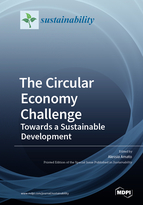The Circular Economy Challenge: Towards a Sustainable Development
A special issue of Sustainability (ISSN 2071-1050). This special issue belongs to the section "Environmental Sustainability and Applications".
Deadline for manuscript submissions: closed (15 December 2021) | Viewed by 37042
Special Issue Editor
Special Issue Information
Dear Colleagues,
The modern economy has been based on a linear design, where the keywords are “take”, “make”, “use”, and “dispose”. This approach has led to constant economic growth that neglects the real limits of our planet. The negative effects have been evident with consequences for both the environmental end the social spheres. Over the last decade, growing attention has been paid to the new model of a circular economy, in response to the global situation. The circular economy is not only a simple business model, but rather the integration of many strategies for the protection of the natural ecosystem and the maintenance of economic stability worldwide. A holistic approach is vital for the success of this new economy, where technological advancement must be combined with the assessment of the possible repercussion on the sustainability spheres (environmental, social, and economic). Many tools can support economy transactions, such as the life cycle assessment, able to push the strategic choices towards the impact reduction, in the most disparate fields.
This Special Issue will collect current knowledge and innovative methods developed in agreement with the main principles of the circular economy. New proposals should provide methods that act on the eco-design of processes/products and to exploit waste flows. Studies should supply unconventional models to evaluate systems from a holistic point of view. The further possibility of the achievement of indexes to describe the circularity level of a system could be essential for the implementation of sustainable policies.
Dr. Alessia Amato
Guest Editor
Manuscript Submission Information
Manuscripts should be submitted online at www.mdpi.com by registering and logging in to this website. Once you are registered, click here to go to the submission form. Manuscripts can be submitted until the deadline. All submissions that pass pre-check are peer-reviewed. Accepted papers will be published continuously in the journal (as soon as accepted) and will be listed together on the special issue website. Research articles, review articles as well as short communications are invited. For planned papers, a title and short abstract (about 100 words) can be sent to the Editorial Office for announcement on this website.
Submitted manuscripts should not have been published previously, nor be under consideration for publication elsewhere (except conference proceedings papers). All manuscripts are thoroughly refereed through a single-blind peer-review process. A guide for authors and other relevant information for submission of manuscripts is available on the Instructions for Authors page. Sustainability is an international peer-reviewed open access semimonthly journal published by MDPI.
Please visit the Instructions for Authors page before submitting a manuscript. The Article Processing Charge (APC) for publication in this open access journal is 2400 CHF (Swiss Francs). Submitted papers should be well formatted and use good English. Authors may use MDPI's English editing service prior to publication or during author revisions.
Keywords
- Circular economy
- Environmental sustainability
- Social sustainability
- Economic sustainability
- Holistic approach
- Life cycle assessment






